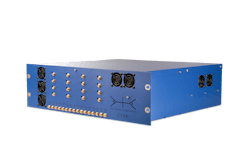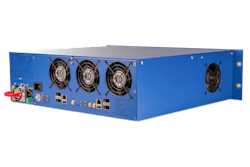Solving data acquisition problems with software-defined radio
Download this article in .PDF format.
Data acquisition (DAQ) is the process of acquiring raw data in the form of a measured electrical or physical phenomenon from various sources and converting it into a measurable signal for processing. Systems used must be capable of acquiring, converting, and transferring data to a processor as quickly and accurately as possible, which is becoming increasingly difficult as the amount of data and the rate at which it needs to be transmitted is constantly rising.
As technology continues to advance, the demands on data acquisition technology have similarly increased, making traditional systems insufficient. Closed architecture and hardware-based technology dedicated to specific applications require different frequencies, bandwidths, modulation modes, and protocols—each presenting very evident disadvantages. Limiting the deployment scenarios, signal types, and applications leads to further disadvantages in terms of cost, production cycle, and compatibility, as well as DAQ’s inability to handle testing and reconfiguration.
These systems are also facing challenges related to storage, processing power, noise control, and data traffic control. Of these, the two that have the greatest impact on DAQ systems today are system integration and unit flexibility. Without these attributes, data can easily be skewed, the capacity of the system is greatly hindered, and costs related to keeping up with changes and demands are high.
Innovation needed
With these problems being recognized, the need for new DAQ systems that are able to overcome these and future challenges is being addressed in new technological developments. Through the integration of both 1) hardware that can handle the stress of the most hostile environments and 2) software that can handle present-day tasks and is easily upgradable to accommodate the advancements necessary for future tasks, there has been a shift to technology that is able to leverage open architecture and emphasize interoperability.
This is especially essential for the combination of wired and wireless technology that must use the same DAQ system. The decision to use wireless or wired solutions is dependent on the system in which it is implemented. Wired solutions are seeing immense improvements, especially through the use of optical cables, which are light and suitable for harsh conditions. Meanwhile, wireless solutions are providing alternatives for problems where wired installations are costly or time consuming to implement, or add significant weight to the system. Remote sensing is also seeing vast improvements in terms of processing power, frequency bandwidth, and interference control—allowing for remote interrogation of sensors. This shift is also essential for enabling the convergence of new technology with existing systems in a wide variety of industries, driving down costs while driving up performance and capabilities.
Putting SDR to use
Interoperability
One of the most requested features for future DAQ systems is the interoperability of different communication systems. Advancements have allowed for the integration of more functionality and higher performance into many of the flexible and programmable components used within SDRs today, which have allowed for the acceleration of innovations in DAQ. This is especially true for FPGAs, which are inherently flexible semiconductor devices used to implement any desired operation within SDRs. Their use has provided SDRs with multifunctionality and programmable logic—emphasizing interoperability. FPGAs also deliver high performance and intense signal and computational processing, which is made attainable through parallel processing.
This makes SDRs well-suited for scenarios that require handling high-bandwidth and high-channel density signals. These attributes extend available operating frequency and permit continuous streaming and allow the use of multiple radio standards on the network through the same hardware, greatly reducing the complexity of the system. Additionally, FPGAs able to perform on-board digital signal processing (DSP), which enables highly-agile target acquisition and filters in the form of triggers and thresholds. This is in order to control signal-to-noise ratio and spurious-free dynamic range on acquired data, helping to achieve gains in sensitivity, range, and quality, while reducing memory and disk usage. These components are also available off-the-shelf, which lowers production time and provides more cost-effective options while allowing for the development of more innovative solutions.
SDRs also offer users flexible radio chains, permitting for high bandwidths and the ability to operate over a wide frequency. This allows for the acquisition, storage, and processing of an uninterrupted stream of data, as well as the maintenance of signal fidelity through a versatile and evolvable information and communication structure. These radio chains permit for the system to adapt to multiple bands concurrently, improving the quality and resolution of the data, which can be acquired quickly and efficiently. SDRs have the added capacity to act as a cognitive radio (CR), offering adaptability in the electromagnetic domain. Instantaneous data transfer is crucial for many industries, and via CRs, systems can be further enhanced with automatic reconfiguration to eliminate delays in data transfer and overcometraffic burdens.
SDR-enabled data-acquisition has the potential to advance many industries, with three of the most noteworthy being test & measurement, signals intelligence, and spectrum scanning.
Test and measurement: As SDRs are able to accommodate multiple standards, they greatly eliminate the complications related to test procedures. This permits a large influx in tests that can be performed on a single device, allowing more data to be moved, and more signals to be processed. SDRs are especially useful in markets where protocols and system architectures are continuously evolving, enabled by SDRs’ open architecture. This has allowed for significant change and added capabilities within the test and measurement market.
Signals intelligence (SIGINT): Signals intelligence is especially necessary within military applications, where it is essential to maintain an upper hand over adversaries in warfare and keeping up-to-date for future missions. SDRs are well-suited for the task, as they are capable of monitoring multiple frequencies simultaneously and can handle high-frequency and high-bandwidth applications in data-acquisition. This has allowed them to enable real-time data analysis, enhanced by techniques and algorithms that aid in identifying, processing, and manipulating data.
Spectrum scanning: Through the use of FPGAs, SDRs are able to generate, process, store, and share digital data acquired on signals. They are further aided by providing the operational agility to best use and gain insight on the spectrum. This has the added benefit of providing users with information on adversaries in military applications, made possible in this application as SDRs have the flexibility to adapt to improvements and modifications in the systems they are monitoring.
Available options
In order to suit data-acquisition applications, SDRs must posses impressive capabilities, further supplemented by their implementation of high-quality components. There are high performance SDR systems available using the latest technology that surpass these requirements. These systems possess the flexibility to process data on-board and offer data transport capabilities in order to accomplish advanced data storage and processing. Leading radios include front-ends, which includeBrandon Malatest graduated from the Honours Physics program at the University of Waterloo, where he spent the majority of the time in experimental physics. He is one of the founders of Per Vices Corporation, a RF and digital systems innovator that supplies multiple industries with high performance software-defined radio platforms. Contact Per Vices at [email protected].




